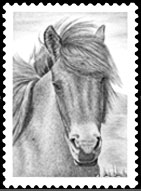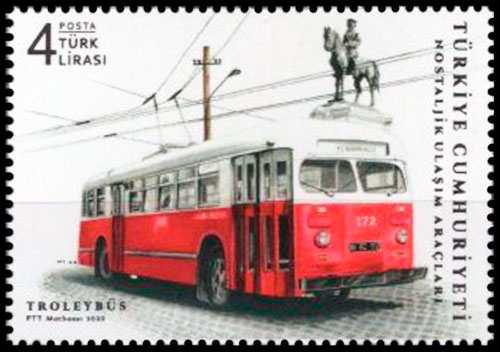
On January 7, 2022, the Turkish Post issued a series of "Nostalgic Means of Transport" consisting of 4 stamps.
This nostalgic series is designed to refresh the memories of the old urban transport, which for many years faithfully served the inhabitants of Turkish cities.
The postage stamps depict a tram, a trolleybus, a city ferry and a suburban train.
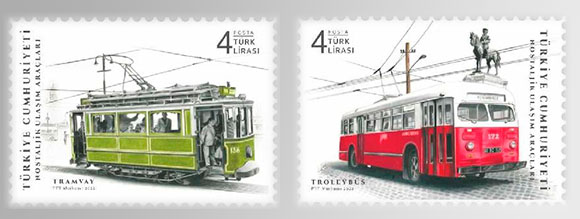
Trams
The first, still horse-drawn trams appeared in Turkey in 1860, then, starting from 1912, trams were gradually electrified, and by the 1950s, many Turkish cities had an extensive network of tram lines. For example, in Istanbul there were as many as 56 lines on which trams ran. However, the tram lines were gradually closed, giving way to other types of urban transport. In Istanbul, trams stopped operating in 1966. However, this type of transport turned out to be stubborn and refused to give up its positions - after 24 years, the trams returned to Istanbul. At the end of 1990, the historic Tunel-Taksim tram line resumed operation, the route was driven by original tram cars taken from museums and prepared for work in a modern city. Then in 2003 the second historical ring line was opened. Historic trams have become not only an efficient mode of urban transport, but also a tourist attraction. At the same time, in parallel, starting from 1992, modern tram lines began to be laid, now 5 city tram lines operate in Istanbul.
Trolleybuses
No less interesting is the history of city trolleybuses. In Turkey, the first trolleybus line appeared in Ankara in 1947. Then trolleybuses began to run in Izmir in 1954 and in Istanbul in 1960, replacing the trams. Trolleybuses were also a very popular type of urban transport, for example, in Ankara in 1952, 33 trolleybuses were already operating on the line. Initially, the cars were purchased in Europe, but in 1968 the first Turkish Tosun trolleybus was produced, created by the workers of the Istanbul Electric Tram and Tunnel Factory (IETT) in the Şişli garage workshop. But time passed and slow trolleybuses ceased to meet the needs of Turkish cities. In 1981 they disappeared from the streets of Ankara, in 1984 they disappeared from Istanbul, trolleybuses lasted the longest in Izmir, they were abolished only in 1992. However, after 21 years, tram history repeated itself with trolleybuses. In 2013, the red Tosun trolleybus, familiar to many, again drove through the streets of Istanbul. Although in fact it became an electric bus, it remained completely identical to the original trolleybus from the 1980s outwardly. It carries passengers on a nostalgic route along the Edirnekapı-Taksim line.
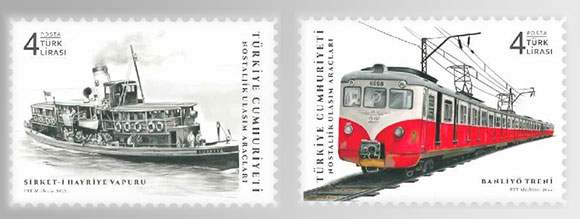
Сity ferryboats
It will seem surprising to some people, but ferries in Turkey are also a type of urban transport, like buses or fixed-route taxis. We are talking, of course, about the Istanbul ferryboats. The Bosphorus Strait divides the city into two parts, plus the European part of Istanbul is also divided into two parts, northern and southern, by the Golden Horn Bay. Therefore, water transport is a vital necessity, allowing city residents and tourists to get from one area of the city to another. The first private steam ferries began to ply the Bosphorus in 1837. At first they were wooden rowing boats, but later they were replaced by screw-type metal boats. In 1945, the city authorities took over the management of the ferries.
Suburban trains
Suburban trains can be found today in three cities in Turkey, Istanbul, Izmir and Ankara. Suburban trains appeared in Ankara in 1929, and traffic on the Sirkeci-Halkali route was opened in Istanbul in 1955. Trains traverse Istanbul from one end of the city to the other along the coast. Izmir has the longest suburban train route in Turkey, with a length of 136 km. Over the past time, some suburban lines have ceased to be operated, while others, on the contrary, are actively developing.
It's all about urban transport, but where is the horse?
A postage stamp with a trolleybus in the background shows an equestrian monument. This is the Victory Monument in Ankara, erected in honor of the victory in the national liberation war of the Turkish people of 1919-1923. The monument is located on Ulus Square, which was Ankara's main square until the 1950s. The monument was created as a result of a nationwide charity campaign organized by journalist Yunus Nadi. The project of the Austrian sculptor Heinrich Krippel won the international competition. The monument was inaugurated on November 24, 1927.
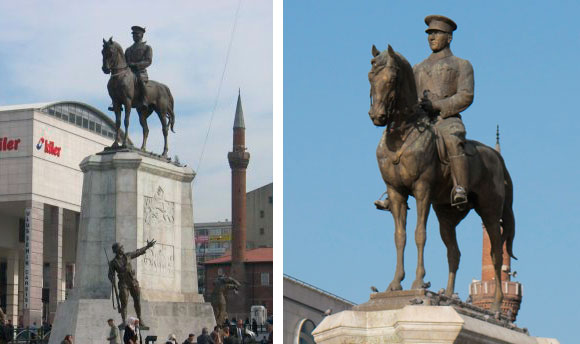
The equestrian statue of the first president of Turkey, Kemal Ataturk, is installed on a high white pedestal, clearly visible from afar. At the foot of the monument there are figures of two soldiers: one is calling the other to battle, and the other is watching the surroundings, looking out for enemies. On the other side of the pedestal is a figure of a woman carrying a cannonball. She personifies the contribution of Turkish women to the war for the independence of the country. In 2002 and 2021, the city authorities carried out serious work.
Postage stamps with a face value of 4 lira each were issued in mini sheets of 9 stamps (3x3) with a circulation of 100,000 copies. Turkey Post also prepared a first day cover. On the day the stamps were issued, they were canceled with a special postmark.
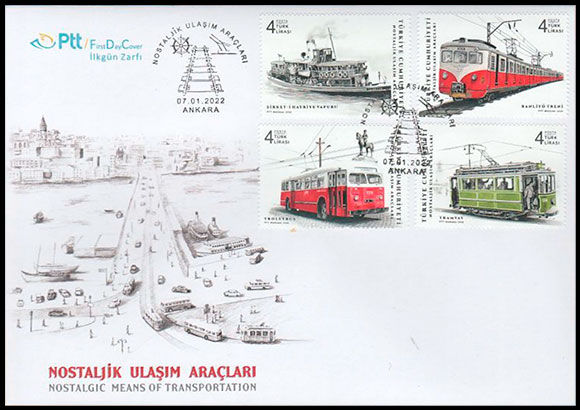
Перейти в каталог
I apologize for any errors or inaccuracies
